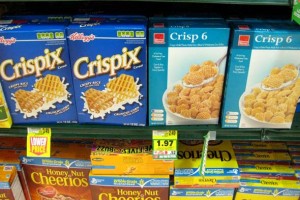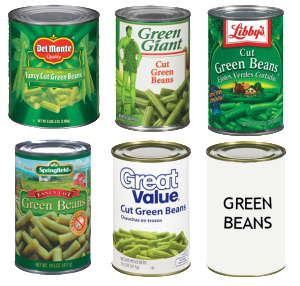When I was a little kid, I remember hanging out with my older cousins. Who knows why, but for some reason one of them mentioned the word “generic”. I didn’t know what that meant so my cousin explained: “You know how on the bottom shelf of the grocery store they sell rice in a bag that just says ‘rice’? That’s ‘generic’. If you’re too poor to buy Uncle Ben’s, that’s what you buy—generic.”
Okay so maybe we weren’t the most politically correct family, but in the early 1980s, that’s what people thought of when they thought about generic products. There wasn’t a fancy term like “store brand” to even try to dress it up.
Growing up, I don’t remember a single time that we bought a generic product. It was always Crest and Gillette and Minute Maid. As a kid I would have been ashamed if we used generic stuff, and horrified if one of my friends from school ever found out. That would be playground suicide.
My, oh, my, how times have changed. Today, store brands have become a legitimate alternative to brand-name products. Even a self-respecting third-grader can hold their head high using Kirkland toothpaste or Kroger green beans. I can hear you saying, “that’s nice and all, but what does that have to do with personal finance?”
The ascendance of store brands has been a huge boon to price conscious consumers. On average they cost about 25% less than brand name. And here’s a dirty little secret that isn’t so secret—a lot of store brands are made by the brand name manufacturers. So for example (and I may get the brand wrong, but you’ll get my point) CVS batteries may very well be made in the same factory that churns our Duracell batteries. The difference is if the label says CVS they cost a lot less.

Other stores have taken it to a new level where their store brand is perceived to be better than the brand name. Trader Joes is a grocery store in which nearly all their products are “Trader Joe” brand, and that chain has a fiercely loyal following. Similarly, Costco sells Kirkland brand, and I can tell you that I trust that more than almost any brand name. The fact that those products tend to cost a lot less is icing on the cake.
Financial impact
So now let’s bring this full circle. When thinking about your finances, you know that inflation is really important. A 1% change in inflation has huge consequences over the course of a few decades; even 0.1% changes in inflation are noticeable.
Now let’s play that ace in the hole we have called store brands. The math is a little rough, but let’s say that using store brands which cost about 25% less is the equivalent of reducing inflation by 0.5% over the next 50 years. The impact is enormous.
Imagine a 22 year old today who invests steadily until she’s 60 and ends up with $1 million. If you assume 3% inflation, that $1 million when she’s 60 is the equivalent of $325,000 today. That’s a lot of money but inflation certainly took a big bite out of it. On the other hand, if you did the little store brand trick and assumed that that could take you to the equivalent of 2.5% inflation, then that $1 million when she’s 60 would be equivalent to $390,000. That’s still a pretty big impact, but using store brands could equate to something like $65,000 in today’s dollars or $180,000 when you retire. And I would bet I’m underestimating this.
What’s the point?
The point of all of this is two-fold. First, there is a lot of money to be saved by going with store brands. The Fox family pretty much exclusively buys store brands when that option is available, and Kirkland brands has a special place in our hearts. But this really isn’t a blog on personal spending, so I’ll leave that there.
The second, and more important, point is that the evolution and popularity of store brands represent an amazing example of how our economy is giving people better and cheaper options. And “better and cheaper” means inflation isn’t as bad as you’d think.
Go back to the early 1980s, and imagine you’re reading The Stocky Fox. Sure I might be wearing a white suit with a pastel t-shirt, but just like now I’d be trying to give good advice on how to best manage your finances. We’d talk about inflation and how you need to plan on it eating away about 4-5% of your money each year.
No one was anticipating that retailers would figure out that they could sell the functionally equivalent product without the brand name for higher profits while passing on savings to the consumers. Yet that’s exactly what happened. Store brands by themselves have probably taken away about 0.5% from the inflation number.
Of course we’re in 2015 so my pastel t-shirts are all packed away, but I’m sure there will be another innovation just like store brands that will offer us better products at lower prices. This will again take a bite out of inflation, and make it turn out to be not as bad as we think it will be. And I’ll have another “inflation killer” to write about.

Really practical info! I hope most people realize by now that it’s true that often you’re buying the EXACT same product in one can as another, only the labels are different, and the price is much less.